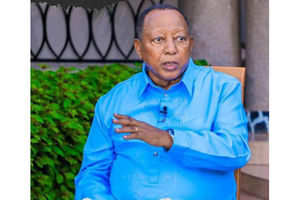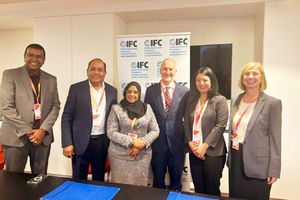Why MV Dar project could fail before its official launch

Works minister John Magufuli (left) is escorted by Coast Regional Commissioner Evarist Ndikilo upon his arrival in Mbegani, Bagamoyo, aboard the MV Dar es Salaam during a trial run last month. PHOTO | FILE
What you need to know:
- New ferry deemed too slow to ply regularly between Dar and Bagamoyo with a view to easing congestion in the city
- The Danish company contracted to build the vessel subcontracted a Bangladeshi firm to do the job
Dar es Salaam. The procurement of the MV Dar es Salaam-Bagamoyo is proving to be controversial following reports that the ferry does not meet specifications and standards for which it was ordered.
Details gathered by The Citizen also show that the Danish company contracted by the government to supply the vessel, JGH Marine, subcontracted Bangladeshi firm Western Marine Shipyard Limited, a fact authorities, however, said they were not aware of. The Citizen has learnt that the speed of the vessel has raised questions over the feasibility of the ferry being deployed for commercial and public transport service as intended. The ferry has reportedly been unable to reach a top speed of 20 knots as requested by the government and, instead, tops out at between 14 and 15 knots.
This means that the ferry, which is expected to ease traffic congestion in Dar es Salaam, takes over three hours to sail between the city and Bagamoyo, with a round trip taking around seven hours. Officials of the Tanzania Electrical, Mechanical and Electronics Services Agency (Temesa), which owns and operates the vessel, are divided on what could escalate into a major scandal ahead of the vessel’s official inauguration by President Jakaya Kikwete in due course.
Works minister John Magufuli floated the idea to build the ferry to ease traffic congestion in Dar es Salaam, which costs the nation approximately Sh400 billion annually.
The government, through Temesa, then went on to commission JGH Marine to build the 300-passenger ferry at a cost of Sh8 billion, fully financed by the government.
“JGH Marine builds and delivers small and mid-size vessels for use in East Africa, Latin America and in developing countries around the world,” the company says on its website.
According to information on the website, the company in 2011 supplied three patrol boats to Tanzania Ports Authority and four to the Ministry of Fisheries and Livestock Development. The boats were assembled at a facility in Mwanza.
In 2009, the firm delivered to Tanroads a ferry to operate across the Pangani River in Tanga Region. The vessel was assembled on site. JGH Marine has also supplied patrol boats to Kenya, where the firm apparently has its regional headquarters.
According to the agreement with Temesa, the MV Dar es Salaam-Bagamoyo was to have a maximum speed of 20 knots, meaning it would have spent approximately one-and-a-half hours sailing between Bagamoyo and Dar es Salaam.
However, during its first trial run from Dar es Salaam to Bagamoyo, the ferry covered the distance in slightly over three hours despite having no cargo and carrying only about half its passenger capacity.
It also did not make any stop on the way. This means that the boat can hardly make two return trips per day, raising concern that the project could prove to be a white elephant.
Before it arrived in the country, the vessel was inspected by engineers from Temesa and the Surface and Marine Transport Regulatory Authority (Sumatra). Four inspections were conducted before its completion last September. A delegation comprising Dar es Salaam Regional Commissioner Said Meck Sadik and officials from the Works ministry and Temesa travelled to Bangladesh in September for the final inspection.
Some delegates raised serious queries about the vessel’s performance during a trial run in Bangladesh.
A marine expert, who spoke to The Citizen on condition of anonymity due to the sensitivity of the matter, says the vessel was supposed to travel between Dar es Salaam and Bagamoyo in one-and-a-half hours in normal conditions.
“It is now virtually impossible for the vessel to serve the purpose it was bought for if the best it can do is cover the distance in three hours,” he said.
However, in an interesting development, Temesa CEO Marcellin Magesa told The Citizen that the boat was not intended to ply the Dar es Salaam-Bagamoyo route, but was meant to operate within Dar es Salaam’s boundaries to ease traffic congestion.
“It is called MV Dar-Bagamoyo because for the time being it will be travelling up to Bagamoyo, but it is not intended for the historical town.
“The aim is to ease congestion by providing alternative means of transport. Congestion is in Dar es Salaam, not Bagamoyo,” Ms Magesa said in an interview.
She said the ferry would stop sailing all the way to Bagamoyo once the construction of three jetties at Kawe, Jangwani Beach and Rungwe Oceanic Hotel was complete.
Further inquiries have established that JGH Marine of Denmark did not actually build the vessel and instead subcontracted Western Marine Shipyard Limited of Bangladesh.
It means that the company that won the tender to build the ferry acted as a middleman, contrary to public procurement rules. JGH Marine and Western Marine did not respond to inquiries about technical and contractual queries related to the project.
But Ms Magesa strongly refuted reports of subcontracting. “The builder is a Danish company…it is the one we entered into a contract with and it is the one which delivered the ferry to us,” she said, adding: “There is nothing like subcontracting unless you have seen the subcontracting agreement.”
The Citizen has established that some Tanzanian experts who travelled to Bangladesh last year for final tests of the ferry gave their approval, paving the way for the Danish firm to bring the vessel to Dar es Salaam.
Western Marine Shipyard actually says on its website that the construction of the vessel supplied to Tanzania is among major works it has undertaken as a subcontractor.
Reports from inside Temesa say members of a special committee that received the vessel were divided on what speed should be indicated in the final report before the ferry is officially launched by President Kikwete.
While others want the anomaly be put on the report, other top officials of the agency insist it should not be mentioned, at least for now.
Speaking after receiving the boat last November, Works minister John Magufuli said: “This is a ferry of its kind because its speed is incomparable with other ordinary ferries we have in the country,” he said, adding that the boat would take a maximum of two hours travelling between Dar es Salaam and Bagamoyo. It is not clear if the minister is in the know about the technical concerns.
Three weeks ago, Dr Magufuli and about 100 passengers endured a three-hour ride from Dar es Salaam to Bagamoyo aboard the ferry. On disembarking in Mbegani, Bagamoyo, Dr Magufuli said:
“It was a smooth and enjoyable ride...the ferry was not pushed to its maximum speed because it was just a test ride, and everything went well.”




